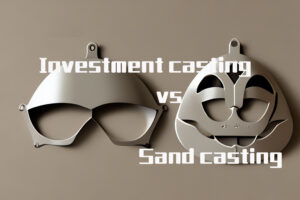Investment Casting vs Sand Casting: Which is the Better Choice?
 When it comes to manufacturing metal parts, there are two popular methods: investment casting and sand casting. Both methods have their own advantages and disadvantages, and choosing the right one depends on the specific needs of the project. In this article, we will explore the differences between investment casting and sand casting, and help you make an informed decision.
When it comes to manufacturing metal parts, there are two popular methods: investment casting and sand casting. Both methods have their own advantages and disadvantages, and choosing the right one depends on the specific needs of the project. In this article, we will explore the differences between investment casting and sand casting, and help you make an informed decision.
Investment Casting
Investment casting, also known as lost-wax casting, is a process that has been used for thousands of years. It involves creating a wax pattern of the part to be cast, coating the pattern with a ceramic shell, and then melting the wax out of the shell. The resulting cavity is then filled with molten metal, which solidifies and takes the shape of the original wax pattern.
One of the biggest advantages of investment casting is its ability to produce complex shapes with high accuracy and detail. This makes it ideal for creating parts with intricate geometries, such as turbine blades, jewelry, and dental implants. Investment casting also produces parts with a smooth surface finish, which requires little to no post-processing.
Another advantage of investment casting is its ability to use a wide range of materials, including stainless steel, aluminum, brass, and bronze. This makes it a versatile process that can be used for a variety of applications.
However, investment casting also has some disadvantages. It is a relatively expensive process, as it requires the creation of a wax pattern and a ceramic shell. It also has a longer lead time than other casting methods, as the wax pattern and ceramic shell must be created before casting can begin.
Sand Casting
Sand casting, also known as sand molded casting, is a process that involves creating a mold from sand and then pouring molten metal into the mold cavity. The sand is held together with a binder, such as clay or resin, and is typically made from silica or olivine sand.
One of the biggest advantages of sand casting is its low cost. It is a relatively simple process that requires minimal equipment, and the sand can be reused multiple times. Sand casting is also a fast process, as the mold can be created quickly and casting can begin immediately.
Sand casting is also a versatile process that can be used to cast a wide range of materials, including iron, steel, aluminum, and copper. This makes it a popular choice for large-scale production of simple parts, such as engine blocks and pipe fittings.
However, sand casting also has some disadvantages. It produces parts with a rough surface finish, which requires post-processing to achieve a smooth surface. It is also limited in its ability to produce complex shapes with high accuracy and detail.
Which is the Better Choice?
So, which casting method is the better choice? The answer depends on the specific needs of the project.
If you need to produce a part with complex geometries and high accuracy, investment casting is the better choice. It produces parts with a smooth surface finish and can use a wide range of materials. However, it is a more expensive process and has a longer lead time.
If you need to produce a large number of simple parts at a low cost, sand casting is the better choice. It is a fast process that requires minimal equipment and can be used to cast a wide range of materials. However, it produces parts with a rough surface finish and is limited in its ability to produce complex shapes with high accuracy and detail.
In conclusion, both investment casting and sand casting have their own advantages and disadvantages. Choosing the right casting method depends on the specific needs of the project, including the complexity of the part, the required accuracy and detail, and the desired surface finish. By understanding the differences between these two casting methods, you can make an informed decision and ensure the success of your project.






